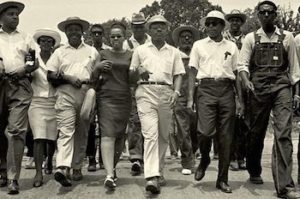
The March Against Fear began on this date in 1966. It was a major demonstration in the 20th-century American Civil Rights Movement in the South.
Activist James Meredith launched the event on June 5, 1966, intending to make a solitary walk from Memphis, Tennessee, to Jackson, Mississippi, via the Mississippi Delta, starting at Memphis's Peabody Hotel and proceeding to the Mississippi state line, then continuing through, respectively, the Mississippi cities of Hernando, Grenada, Greenwood, Indianola, Belzoni, Yazoo City, and Canton before arriving at Jackson's City Hall. The total distance marched was approximately 270 miles for 21 days.
The goal was to counter Jim Crow racism in the Mississippi Delta after the passage of federal civil rights legislation in the previous two years and to encourage African Americans in the state to register to vote. He invited only individual black men to join him and did not want it to be a large media event dominated by major civil rights organizations. On the second day of his walk, June 6, Meredith was shot and wounded by James Aubrey Norvell, a white sniper, and was hospitalized for treatment.
Many civil rights organizations rallied to the cause, vowing to carry on the march in Meredith's name to the state capital. The state committed to protecting the marchers. The Student Nonviolent Coordinating Committee (SNCC), the Southern Christian Leadership Conference (SCLC), the Mississippi Freedom Democratic Party (MFDP), the Congress of Racial Equality (CORE), and the Medical Committee for Human Rights (MCHR) took part, with Deacons for Defense and Justice from Louisiana providing armed protection. The different groups and leaders struggled over tactics and goals but cooperated in community organizing and voter registration.
They registered more than 4,000 Blacks to vote in counties along the way. Some people marched briefly; others stayed through all the events; some national leaders took intermittent part. In addition, labor leader Walter Reuther and his wife May traveled from Chicago to march and brought ten buses full of union supporters. During the latter days of the march, Stokely Carmichael, the new chairman of SNCC, introduced the idea of Black Power to a broad audience. Rev. Martin Luther King Jr. participated and continued to attract admiring crowds; his leadership and reputation brought numerous people to see him, inspiring some to join the march.
As the march headed south, the number of participants grew. Finally, an estimated 15,000 mostly black marchers entered the capital of Jackson on June 26, making it the largest civil rights march in the state's history. The march catalyzed continued community organizing and political growth among African Americans in the state over the following years. Since then, they have maintained a high rate of voting and participation in politics. The march expressed "both the depths of black grievances and the height of black possibilities," It had to do with "oppressed people controlling their destiny."